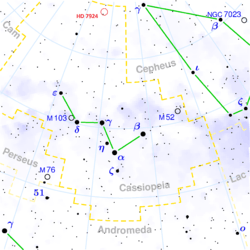HD 7924
HD 7924 is a single[9] star located 55.5[1] light years away from the Sun in the northern constellation of Cassiopeia, near the northern constellation border with Cepheus. It has an orange hue and is only visible by means of binoculars or a telescope due to a low apparent visual magnitude of 7.167.[2] The star is drifting closer to the Sun with a radial velocity of –22.7 km/s,[1] and is expected to approach to within 9.3 light-years in around 711,700 years.[10]
| Observation data Epoch J2000.0 Equinox J2000.0 | |
|---|---|
| Constellation | Cassiopeia |
| Right ascension | 01h 21m 59.1132s[1] |
| Declination | +76° 42′ 37.0373″[1] |
| Apparent magnitude (V) | 7.167[2] |
| Characteristics | |
| Evolutionary stage | main sequence |
| Spectral type | K0.5V[3] |
| Apparent magnitude (B) | 8.005[2] |
| Apparent magnitude (J) | 5.618[4] |
| Apparent magnitude (H) | 5.231[4] |
| Apparent magnitude (K) | 5.159[4] |
| B−V color index | +0.826±0.006[5] |
| Astrometry | |
| Radial velocity (Rv) | −22.70±0.15[1] km/s |
| Proper motion (μ) | RA: −34.643±0.041[1] mas/yr Dec.: −32.660±0.038[1] mas/yr |
| Parallax (π) | 58.8216 ± 0.0249[1] mas |
| Distance | 55.45 ± 0.02 ly (17.001 ± 0.007 pc) |
| Absolute magnitude (MV) | 6.04[5] |
| Details[6] | |
| Mass | 0.81±0.01 M☉ |
| Radius | 0.74±0.01 R☉ |
| Luminosity | 0.364±0.001 L☉ |
| Surface gravity (log g) | 4.6±0.01 cgs |
| Temperature | 5,216±13 K |
| Metallicity [Fe/H] | −0.15±0.03 dex |
| Rotational velocity (v sin i) | 0.9[7] km/s |
| Age | 3.0±1.8 Gyr |
| Other designations | |
| Database references | |
| SIMBAD | data |
| Exoplanet Archive | data |
| ARICNS | data |
| Extrasolar Planets Encyclopaedia | data |
This is a K-type main-sequence star with a stellar classification of K0.5V.[3] Low-level chromospheric activity has been detected, with the star showing spots and an activity cycle.[9] The star is about three[6] billion years old and is spinning with a projected rotational velocity of just 0.9 km/s.[7] It has 81% of the mass of the Sun and 74% of the Sun's radius. The metal content is about seven-tenths as much as the Sun. It is radiating 36.4% of the luminosity of the Sun from its photosphere at an effective temperature of 5,216 K.[6]
In 2009, a super-Earth exoplanet was found in orbit around the star.[11] In 2015, two more planets were discovered, and the mass of the original planet was revised downwards slightly.[12][9] It is possible that planets c and d are in the 8:5 mean motion resonance.[13] All of the planets lie inside the star's habitable zone.[9]
| Companion (in order from star) |
Mass | Semimajor axis (AU) |
Orbital period (days) |
Eccentricity | Inclination | Radius |
|---|---|---|---|---|---|---|
| b | ≥ 8.68±0.52 M⊕ | 0.05664±0.00068 | 5.39792±0.00025 | 0.058 +0.056 −0.040 |
— | — |
| c | ≥ 7.86±0.72 M⊕ | 0.1134±0.0014 | 15.299±0.0033 | 0.098 +0.096 −0.069 |
— | — |
| d | ≥ 6.44±0.79 M⊕ | 0.1551±0.0019 | 24.451±0.016 | 0.21 +0.13 −0.12 |
— | — |
See also
- List of extrasolar planets
References
- Brown, A. G. A.; et al. (Gaia collaboration) (August 2018). "Gaia Data Release 2: Summary of the contents and survey properties". Astronomy & Astrophysics. 616. A1. arXiv:1804.09365. Bibcode:2018A&A...616A...1G. doi:10.1051/0004-6361/201833051. Gaia DR2 record for this source at VizieR.
- Høg, E.; et al. (2000). The Tycho-2 catalogue of the 2.5 million brightest stars. Astronomy and Astrophysics. 355. pp. L27. Bibcode:2000A&A...355L..27H. doi:10.1888/0333750888/2862. ISBN 978-0333750889.
- von Braun, Kaspar; et al. (2014). "Stellar diameters and temperatures - V. 11 newly characterized exoplanet host stars". Monthly Notices of the Royal Astronomical Society. 438 (3): 2413–2425. arXiv:1312.1792. Bibcode:2014MNRAS.438.2413V. doi:10.1093/mnras/stt2360.
- Cutri, R. M.; et al. (June 2003). "2MASS All Sky Catalog of point sources". NASA/IPAC. Bibcode:2003tmc..book.....C. Cite journal requires
|journal=(help) - Anderson, E.; Francis, Ch. (2012). "XHIP: An extended hipparcos compilation". Astronomy Letters. 38 (5): 331. arXiv:1108.4971. Bibcode:2012AstL...38..331A. doi:10.1134/S1063773712050015.
- Bonfanti, A.; et al. (2015). "Revising the ages of planet-hosting stars". Astronomy and Astrophysics. 575. A18. arXiv:1411.4302. Bibcode:2015A&A...575A..18B. doi:10.1051/0004-6361/201424951.
- Luck, R. Earle (January 2017), "Abundances in the Local Region II: F, G, and K Dwarfs and Subgiants", The Astronomical Journal, 153 (1): 19, arXiv:1611.02897, Bibcode:2017AJ....153...21L, doi:10.3847/1538-3881/153/1/21, 21.
- "HD 7924". SIMBAD. Centre de données astronomiques de Strasbourg. Retrieved 2019-11-07.
- Fulton, Benjamin J.; et al. (2015). "Three Super-Earths Orbiting HD 7924". The Astrophysical Journal. 805 (2): 175. arXiv:1504.06629. Bibcode:2015ApJ...805..175F. doi:10.1088/0004-637X/805/2/175.
- Bailer-Jones, C.A.L.; et al. (2018). "New stellar encounters discovered in the second Gaia data release". Astronomy & Astrophysics. 616: A37. arXiv:1805.07581. Bibcode:2018A&A...616A..37B. doi:10.1051/0004-6361/201833456.
- Howard, Andrew W.; et al. (2009). "The NASA-UC Eta-Earth Program. I. A Super-Earth Orbiting HD 7924". The Astrophysical Journal. 696 (1): 75–83. arXiv:0901.4394. Bibcode:2009ApJ...696...75H. doi:10.1088/0004-637X/696/1/75.
- Sanders, Robert (April 28, 2015). "Robotic telescope discovers three super-Earth planetary neighbors". Berkeley News. UC Berkeley. Retrieved 2019-11-07.
- Kane, Stephen R. (2016). "Resolving Close Encounters: Stability in the HD 5319 and HD 7924 Planetary Systems". The Astrophysical Journal. 799 (1). 105. arXiv:1411.5374. Bibcode:2016ApJ...830..105K. doi:10.3847/0004-637X/830/2/105.
